Exploring Cabinet Refinishing Techniques and Benefits
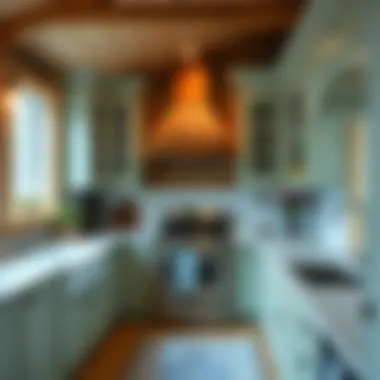
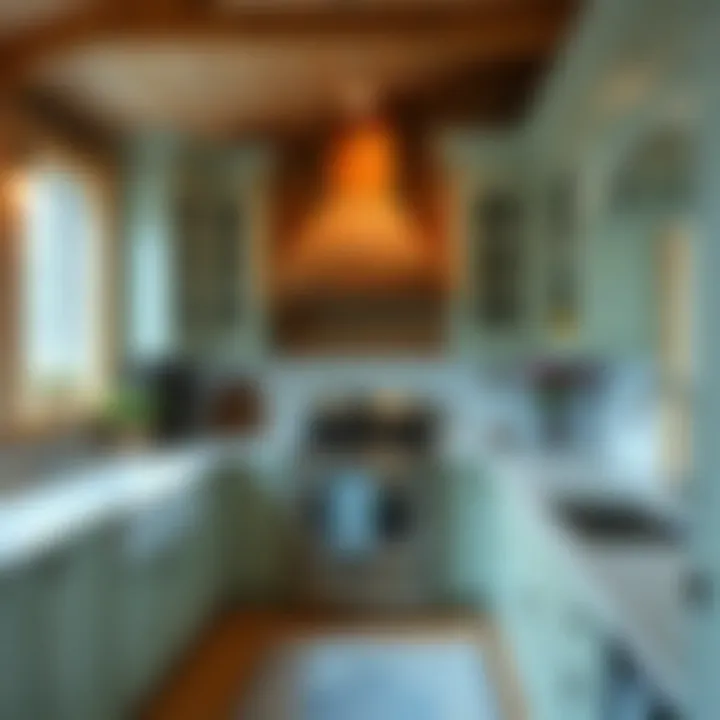
Intro
Cabinet refinishing is often a forgotten gem in the realm of home improvement, yet it holds the potential to breathe new life into tired kitchen or bathroom spaces. With cabinets being such a focal point in our homes, how they look can dramatically influence the overall aesthetic. Whether you’re aiming for a sleek modern vibe or a cozy farmhouse feel, refinishing your cabinets can bring that vision to reality without the hefty price tag of replacements.
Why should you consider cabinet refinishing? For one, it allows homeowners to retain their existing cabinetry, which can often be of quality construction, while updating their appearance to align with contemporary trends. This method also appeals to those wanting a sustainable approach in home design by reducing waste and making the most of already available materials.
In essence, cabinet refinishing combines craftsmanship and creativity. This article will cover the nitty-gritty of the process, from understanding various techniques and styles to the benefits of refinishing over outright replacement. By the end, you should feel more confident whether you're brushing up your own cabinets or collaborating with a professional.
Design Inspirations
When it comes to cabinet refinishing, design inspiration can be a game-changer. There are two major areas to focus on: trending styles and color palettes.
Trending Styles
Today’s homeowners are leaning towards clean lines and minimalistic designs, but that doesn’t mean there’s a lack of personality. Here’s what’s catching eyes:
- Modern Farmhouse: Picture rustic charm combined with contemporary touches—shaker style doors and distressed finishes resonate well here.
- Industrial: Think metal hardware, bold colors, and raw finishes—a look that embraces imperfections.
- Scandinavian: Light colors with an emphasis on natural wood and simplicity, creating a calm and inviting atmosphere.
These styles create a foundation to begin envisioning your own cabinet makeover. Each offers unique traits that can either entirely change the mood of a space or enhance a pre-existing theme.
Color Palettes
Choosing the right color scheme can be both exciting and daunting. Fortunately, some themes have emerged that align well with current design sentiments:
- Neutrals: Shades like beige, white, and soft gray establish a fine backdrop and allow other elements in the space to shine.
- Bold Contrasts: Deep navy or charcoal paired with bright whites can create a striking visual interest.
- Natural Hues: Earthy tones inspired by nature—think forest greens or clay reds—can make your kitchen feel more grounded.
Consider trying a two-toned cabinet approach with different colors for the uppers and lowers. This adds depth and character to the environment, breaking up monotony in a seamless way.
"Color is the keyboard, the eyes are the harmonies, the soul is the piano with many strings." – Wassily Kandinsky
Maintenance and Upkeep
Once you’ve achieved the look of your dreams through refinishing, keeping those cabinets in shipshape is crucial. Here are essential maintenance strategies to ensure they stay as beautiful as the day you completed them.
Seasonal Maintenance Checklist
- Inspect: Regularly check for wear, scratches, and water damage. Addressing these issues right away can prevent larger problems later on.
- Re-seal: Depending on the finish, resealing wood cabinets at least once a year can help protect against moisture and keep the color vibrant.
- Tighten Hardware: Drawers and doors may loosen over time, so periodic tightening ensures longevity.
Cleaning and Organization Tips
- Gentle Cleaners: Use pH-balanced cleaners that won’t strip finish. Solutions like vinegar and water or specialized cabinet cleaner are often best.
- Declutter: Regularly remove items from cabinets to keep them tidy and assess if everything you store is necessary.
- Categorize: Organizing similar items together can make reaching for essentials quick and easy, making not just a cleaner look but a functional space too.
Maintaining your refinished cabinets is all about keeping them sleek and functional while alleviating stress in your living space.
For more information on maintaining the integrity of your cabinets, consider visiting Wikipedia for a broader look at care tips.
Prolusion to Cabinet Refinishing
When it comes to home improvement, the kitchen often takes center stage. One of the most impactful changes you can make is to the cabinetry. Cabinet refinishing is a nuanced approach that not only rejuvenates the look of your kitchen but also breathes new life into your home’s aesthetic. This section aims to highlight the significance of cabinet refinishing, covering its definition, benefits, and considerations to keep in mind.
Defining Cabinet Refinishing
Cabinet refinishing involves restoring the existing cabinets instead of outright replacing them. It typically includes processes such as sanding, staining, or painting, and can also entail updating hardware for a fresh look. Unlike a full remodel, which can be a time-consuming and costly venture, refinishing is often a more manageable project that can yield dramatic results with less effort. By choosing this path, homeowners can preserve their kitchen's original structure while achieving a new finish that aligns with their current decor preferences.
The Importance of Cabinet Refinishing in Interior Design
Cabinet refinishing plays a pivotal role in the overall design of a kitchen. It allows for customization without breaking the bank. Modern design often leans toward sleek and minimalistic looks, and refinishing can help adapt older cabinets to fit these trends.
- Enhances Property Value: Stylish cabinets can significantly enhance the value of your home, making it more appealing to potential buyers.
- Sustainability Factor: In an age where sustainability matters, refinishing allows homeowners to reduce waste by reusing existing materials.
- Personal Touch: Refinishing offers an opportunity for personalization. Whether you opt for a bold color or a classic stain, it allows you to express your unique style.
"Refinishing cabinets not only transforms your space but also helps preserve the environment by reducing waste."
Techniques of Cabinet Refinishing
Cabinet refinishing is not just a mere touch-up; it’s a transformation that can breathe new life into worn cabinetry. The techniques involved in this process are vital as they not only influence the final appearance but also determine the durability and longevity of the refinished cabinets. The right techniques can make a world of difference in both the visual appeal and the practicality of your cabinets.
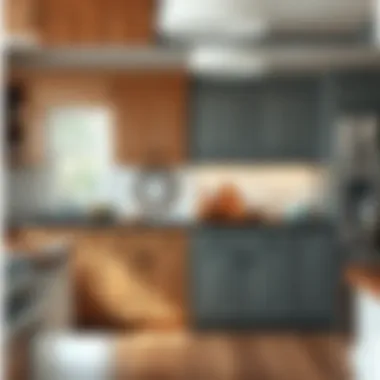
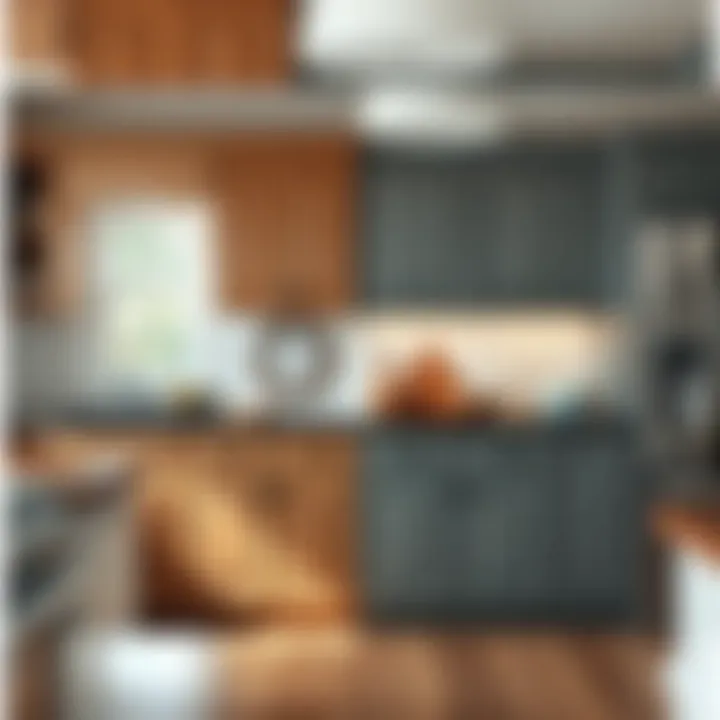
Sanding and Stripping
Sanding and stripping form the bedrock of any refinishing job. These methods prepare the surface adequately to ensure the new finish adheres properly, preventing peeling or flaking down the line. Each plays a pivotal role in polishing up old cabinets, clearing away years of grime, and underlying stains.
Materials Needed
When embarking on a sanding and stripping endeavor, the choice of materials is crucial. The most common items typically include:
- Sandpaper: Different grits are employed—rougher grits for heavy material removal and finer grits for smoothing surfaces.
- Stripping Agents: Chemical strippers help in removing old paint or finish. For instance, products like Citristrip are popular due to their effectiveness without harsh fumes.
- Protective Gear: Safety goggles and masks prevent inhalation of dust and chemicals.
These materials contribute immensely to the success of the project. With quality sandpaper and effective stripping agents, the preparation stage can be swift and efficient, allowing for a pristine foundation before the actual refinishing begins. It's worth noting that while chemical strippers are effective, their application requires care to avoid damage to the wood.
Step-by-Step Process
The process of sanding and stripping is both an art and a science. Here’s a simplified approach:
- Prepare the Workspace: Ensure ample ventilation and cover surrounding areas to catch any dust or drips.
- Remove Cabinet Doors and Hardware: This allows access to all surfaces and makes handling easier.
- Apply Stripping Agent: Follow instructions for application time, usually allowing the product to penetrate for about 30 minutes.
- Scrape Off Old Finish: Use a plastic scraper gently to avoid damaging the wood beneath.
- Sand the Surface: Start with a higher grit sandpaper, gradually moving to finer grits.
- Clean the Surface: Wipe down with a damp cloth to remove dust and debris, ensuring it's ready for finishing.
This step-by-step method is beneficial as it not only provides clarity but also divides the task into manageable portions. Following the process helps in avoiding mishaps that could arise from a rushed job or incomplete preparation, ensuring that the final refinishing job stands the test of time.
Staining versus Painting
Deciding between staining or painting cabinets can feel like choosing between apples and oranges. Both options have their unique attributes, yet they cater to different aesthetics and needs.
Selecting the Right Finish
The choice of finish directly affects not only the look but the inherent qualities of the cabinets—durability, cleanability, and overall feel. Stains, for instance, enhance the natural grain, bringing out the cabinetry's character. On the other hand, paint can offer a wider array of colors, allowing for more creative expressions.
When selecting finish, one must consider:
- Existing Cabinet Color: It’s often easier to stain over wood that has a natural tone whereas paint requires complete removal of previous layers.
- Intended Style: If you lean towards a rustic vibe, stains work wonders. For a modern touch, paints can achieve sleek finishes.
The careful selection of finish ensures that the cabinets not only match your decor but also remain functional over the years.
Considerations for Color Selection
Color holds significant power in any home design. It sets the mood and influences perception. When choosing a color, it's essential to take a few factors into account:
- Room Lighting: Natural and artificial light can drastically affect how colors appear. A color that seems perfect in the store might seem different in your kitchen.
- Complementary Colors: Think about the surrounding decor and how your cabinet color will interact with it, whether it clashes or harmonizes.
- Trends vs. Timelessness: While it might be tempting to follow trends, consider whether the color will stand the test of time in your home.
The selection process for color is essential, as it can define the ambiance of the entire space. Choosing wisely ensures that the refinished cabinets will not only appeal to current tastes but will continue to be a source of satisfaction for years to come.
Applying New Hardware
Finishing touches can make all the difference. Applying new hardware is an excellent way to enhance both the function and appearance of refinished cabinets. New knobs and pulls can serve as beautiful accents, tying the whole look together, whether aiming for a modern aesthetic or a more traditional feel.
New hardware can easily elevate the entire design of the cabinetry, making it more appealing without extensive work. Consideration in hardware choice can be the difference between merely refinished cabinets to cabinets that make a lasting impression.
Thoughtfully consider your options when it comes to the final touches; often, it’s the details that set a project apart.
Benefits of Refinishing Cabinets
Refinishing kitchen and bathroom cabinets can be a game changer for your home. The benefits of this process extend beyond mere aesthetics, offering significant advantages that resonate with both your wallet and the environment. In this section, we’ll delve deeper into the concrete benefits of refinishing your cabinets, laying out why it’s a worthwhile investment for any homeowner.
Cost-Effectiveness
When it comes to home renovations, the cost can spiral out of control quicker than you can say "DIY project." Refinishing cabinets tends to be much cheaper compared to replacing them entirely. Imagine this: a brand new set of high-quality cabinets might set you back several thousand dollars, while refinishing could cost a fraction of that. This makes it an appealing option for those looking to enhance their space without breaking the bank.
Moreover, refinishing extends the life of existing cabinets, letting you enjoy what you already possess without extra expenditure. Any savvy homeowner understands that saving a few bucks here and there can add up to solid savings over time. Here’s a clearer breakdown for you:
- Refinishing vs. Replacement Costs: Refinishing often ranges from $500 to $1,500 depending on the condition of your cabinets, while new cabinets might cost upwards of $4,000.
- Labor Costs: Professional refinishing services will usually charge a fraction compared to full-scale remodeling. It’s a small price to pay for a major transformation.
- Avoiding Landfill Waste: By opting to refinish rather than replace, you’re also keeping materials out of the landfill, which we’ll touch on next.
Sustainability and Environmental Impact
Let’s not kid ourselves; modern life can be wasteful. From fast fashion to disposable gadgets, sustainability often gets tossed aside for convenience. However, refinishing your cabinets is a more eco-friendly route to take. When you decide to breathe new life into your existing cabinets, you’re reducing your carbon footprint in the process. Here’s how:
“Refinishing cabinets not only revives their beauty but also conserves valuable resources.”
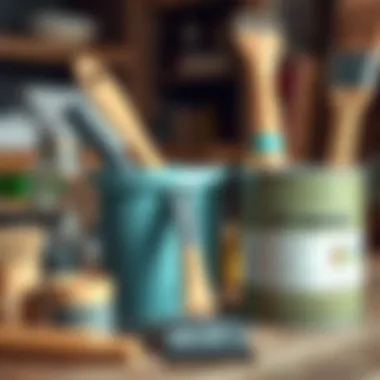
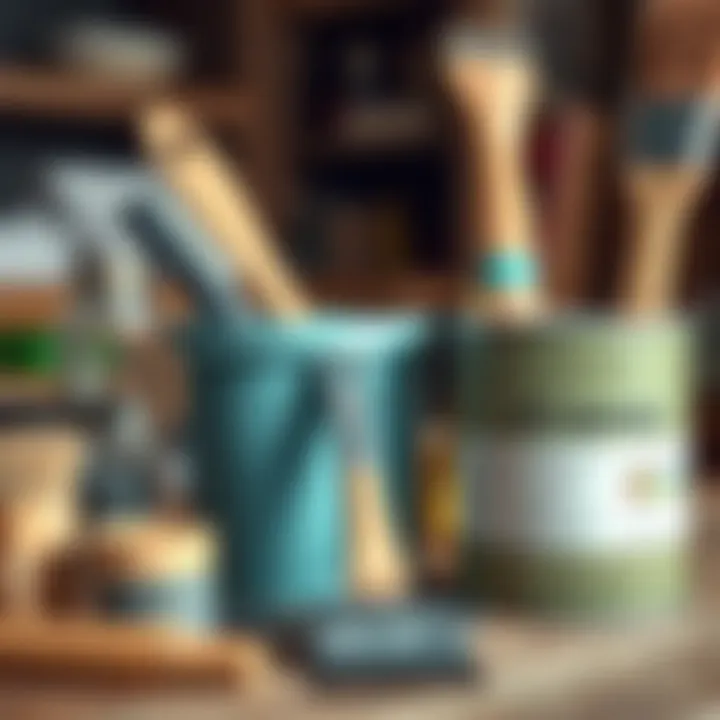
- Less Waste: Refurbishing keeps old materials out of landfills, which is a pressing issue in the world today. Woods like oak and maple, used in many cabinets, can be hard to replace if discarded improperly.
- Sustainable Choices: You can use low VOC (Volatile Organic Compound) paints and stains, fostering a healthier indoor environment. Many non-toxic options now exist on the market.
- Conservation of Resources: Every cabinet saved from disposal means less demand for new timber and other resources used to manufacture new ones.
Personalization and Customization
Every homeowner has a unique vision for their space. Personal touches can make a house feel like a home. Refinishing cabinets allows for a deep dive into creativity, enabling you to express your individual style without hassle. Here’s how customization plays a role:
- Choose Your Colors: Whether you’re mounting a bold navy blue or a muted sage green, refinishing permits a broad canvas for color selection, without committing to an extensive remodel.
- Incorporate Finishes: From matte to glossy, the type of finish can completely alter the way your cabinets look and feel, taking ordinary to extraordinary.
- Unique Hardware: Add new knobs and pulls to complement the new finish, creating an entirely new aesthetic that can reflect the overall style of your home.
Refinishing cabinets offers a lot more than merely a new surface. It’s a chance to reinvent a piece of your home, aligning with your environmental values, while being kinder to your budget.
For further details, refer to Wikipedia and other related resources on home renovations.
Key Considerations Before Starting a Cabinet Refinishing Project
Before diving into a cabinet refinishing adventure, it's crucial to take a step back and give some thought to several key aspects. This preparation can save you from unnecessary headaches and ensure a smoother process. Here, we’ll touch on the major considerations that homeowners should evaluate, each playing a part in determining if refinishing those cabinets is the way to go.
Assessing the Condition of Existing Cabinets
The first major step in any refinishing project is to assess the condition of your cabinets. Not all cabinets are created equal, and their condition can vary significantly depending on factors like age, material, and previous care. Take a close look for visible damage such as scratches, dents, or deteriorating surfaces.
- Surface Damage: Inspect for gouges, peeling paint, or faded finishes. If the damage is extensive, intensive refinishing may be essential, or worse, replacement may be in order.
- Stability: Gently shake the doors and drawers to check stability. Loose hinges or warped doors can signal underlying issues that might complicate refinishing.
- Material Matters: Know what your cabinets are made of. Solid wood cabinets tend to hold up better than particle board, which might not withstand the refinishing process.
Once you've made a thorough assessment, it’s easier to gauge whether these cabinets are worth the effort. You want to avoid the situation where you invest time and resources into a project that may not yield satisfactory results.
Determining if Refinishing is the Right Choice
After assessing your cabinets, the next question is whether refinishing is even the right path to take. This decision should be based on the condition of the cabinets and your goals. Sometimes, the clarion call of a fresh design may tempt you to overhaul your kitchen entirely, but is it necessary?
- Cost vs. Benefit: Weigh the costs associated with refinishing against total replacement. Refacing cabinets often provides a new look for a fraction of the price.
- Lifestyle Considerations: Consider how you use your kitchen. If your kitchen sees a lot of foot traffic or wear and tear, refinishing those cabinets might provide a quick upgrade without the fuss of a full remodel.
- Future Trends: If you're looking to sell your home soon, picking a scheme that aligns with current trends can increase your home’s value. Are you willing to embrace a slightly less trendy design for the sake of keeping your existing cabinets?
Understanding these factors can help you make a more informed decision about whether to refinish or completely replace your cabinets.
Understanding Time and Effort Involved
Finally, let’s talk about the time and effort needed to properly refinish your cabinets. While refinishing is often marketed as a ‘weekend project,’ many homeowners quickly find it’s not as cut and dry as it seems. It involves multiple steps that collectively require a significant investment in both time and energy.
- Preparation Time: Depending on the cabinets' condition, you may spend several days just preparing the surface for painting or staining. This includes cleaning, sanding, and repairing.
- Drying Times: Don’t forget the drying times involved between coats of paint or stain. Jumping the gun can result in an uneven finish or damaged work.
- Skill Level: Assess your own skills realistically. If you have little experience, factor in a learning curve. It might be wise to set aside extra time for trial and error.
"Proper planning prevents poor performance"; understanding the time commitment and effort required can help set realistic expectations and lead to a more successful outcome.
In wrapping up this section, proper consideration of these key elements can significantly influence the outcome of your cabinet refinishing project. By taking the time to assess the condition of your cabinets, weigh the right choices, and understand the effort involved, you set the stage for a satisfying transformation.
Professional vs. DIY Refinishing
When it comes to refinishing cabinets, homeowners often face a pivotal choice: hire a professional or tackle the project themselves. Understanding the landscape of both options helps in making an informed decision based on one's own skills, resources, and the desired outcome. Each path offers unique benefits and considerations that should be analyzed closely before diving in.
When to Hire a Professional
Hiring a professional for cabinet refinishing can be the right choice in several scenarios. If a homeowner lacks experience in DIY projects, navigating technical aspects of refinishing can be daunting. Professionals come equipped not only with skills but also with the right tools and expertise to handle challenges that may arise during the process.
For instance, if the cabinets are intricately designed or if there is an ornate finish, a pro will likely achieve a far superior result than someone who is just beginning. Another reason to call in an expert is time; professionals can often complete a job much more swiftly because they don't have to learn on the go. The cost might be higher, but frequently the results justify the price tag.
DIY Refinishing: A Step-by-Step Approach
Opting for a DIY approach has its own appeal. Many homeowners enjoy the satisfaction that comes from completing a project with their own hands. This path is not just about saving money; it offers a personal touch to the cabinets being refinished. Here, we can elaborate on key aspects to consider.
Safety Precautions
Engaging in DIY cabinet refinishing requires one to consider safety precautions seriously. Before proceeding, wearing protective gear such as masks and goggles is essential to avoid inhaling dust or fumes from chemicals. Proper ventilation is also unfathomably critical, ensuring that harmful vapors dissipate and do not accumulate in an enclosed space.
Furthermore, understanding how to safely use your tools can prevent accidents. Using sharp or power tools without proper training could lead to injuries. While this may seem like a no-brainer, many underestimate the risks involved. Investing time in learning safety practices isn't just wise; it’s a requisite for a successful DIY project.
Required Tools
The tools necessary for a successful DIY cabinet refinishing job can vary widely based on the project’s specifics. Basic equipment might include sanders, brushes, and applicators. For stripping existing finishes, chemical strippers, and heat guns can prove invaluable. Shopping for tools that are effective yet user-friendly is advisable for those who may be novices in this area.


However, the downside of a DIY approach often comes down to the learning curve. If you rush to a hardware store and grab the first tools you see, it might not end well. Inadequate tools can lead to poor results, which diminishes the overall excitement of what could have been a rewarding project. Thus, prioritizing quality over quantity is beneficial when gathering tools for your venture.
"When you do it yourself, there's a unique satisfaction that can’t be purchased, but thorough preparation is the key to a smooth experience."
In summary, whether to pursue a professional service or a DIY project hinges on individual capability, the complexity of the cabinet design, and one’s willingness to endure the learning process. Ultimately, clarifying these details will lead to the most satisfying refinishing outcome.
Long-Term Maintenance of Refinished Cabinets
Cabinet refinishing is not just about giving your cooking space a facelift; it’s an investment that demands ongoing attention. Proper long-term maintenance of refinished cabinets significantly extends their life and keeps them looking fresh, ensuring that the effort—and money—spent on the refinishing process doesn't go down the drain. Understanding the nuances of maintaining newly refurbished cabinets is essential, as it helps avoid common pitfalls and preserves their aesthetic appeal.
Neglecting this upkeep can lead to premature wear and tear, undermining your initial refinishing work. By implementing a regular maintenance routine, you're not only safeguarding your investment but also enriching the overall beauty of your kitchen or bathroom.
Cleaning Best Practices
To keep your cabinets sparkling, proper cleaning methods are essential. Here are a few best practices:
- Use Gentle Cleaners: Avoid abrasive cleaners that can scratch the surface. Opt for a mild detergent mixed with warm water or wood-safe cleaners.
- Microfiber Cloths: Incorporate microfiber cloths into your routine; they are excellent for gently removing dirt and grime without damaging surfaces.
- Avoid Excess Water: Cabinets don’t take well to water; be sure to wring out your cloth, ensuring it’s damp, not soaking wet. This prevents water from seeping into joints and causing damage.
- Spill Management: Clean up spills promptly, especially sticky substances like honey or sauce, as they can tarnish the finish if left too long.
"Routine care can make all the difference, turning small tasks into lasting beauty."
Keeping the cabinets free from harsh chemicals or extreme temperatures is key; both can mar the finish over time. Regular upkeep not only enhances appearance but also extends the lifespan of the refinished cabinetry.
Periodic Refinish: When to Consider It
Even with regular cleaning, every once in a while your refinished cabinets might need a bit more than just a wipe-down. Recognizing the signs for a periodic refinish can save you from deeper issues later on. Here’s when you should consider giving your cabinets another go:
- Visible Wear and Tear: Look out for chips, scratches, or faded areas that stand out against the rest of the cabinet. These blemishes can become worse if not addressed.
- Water Damage: If your cabinets start to feel warped or swell, it's time to act. This often indicates that moisture has penetrated the finish.
- Staining Issues: Persistent stains that don’t come off despite your best cleaning attempts may suggest that the finish is compromised and needs restoration.
- Style Changes: If you decide to shift your interior design style, a fresh finish can bring your cabinets in line with your new aesthetic vision.
Revisiting the finish doesn't require a complete overhaul every time; a light sanding and a new coat of sealer or finish can sometimes do the trick. The goal is to keep that pristine look and durability, safeguarding your investment in your home.
By understanding the long-term maintenance needs of refinished cabinets, homeowners can continue to enjoy their kitchen or bathroom aesthetics for years to come. Periodic checks and care are essential to maintaining beauty and functionality.
Exploring Trends in Cabinet Refinishing
Cabinet refinishing trends not only provide a fresh look but also align with evolving styles and homeowner preferences. As people become more environmentally conscious, the practice of revitalizing existing cabinetry rather than replacing it entirely has gained traction. Notably, refinishing opens doors to creativity—where past designs might stifle imagination, the current trends celebrate individual style and functionality. In this section, we will dive into both the popular styles on the market today as well as consider where cabinet design is headed in the near future.
Current Styles and Finishes
The styles prevalent in cabinet refinishing speak volumes about current design sensibilities. Homeowners are favoring minimalistic aesthetics, often opting for muted colors like soft grays and whites. These tones provide a clean backdrop for colorful decor and accessories. Similarly, there's a noticeable pivot to rustic finishes, which brings a touch of warmth and earthiness into modern interiors. For instance:
- Matte Finishes: They have taken the spotlight, giving cabinets a modern edge while reducing the visibility of fingerprints and scratches.
- Colorful Pops: Deep blues or forest greens are cementing their place as standout colors against neutral palettes.
- Natural Wood: Refinishing that highlights the grain through the application of clear coats is winning hearts, with a growing trend of using reclaimed wood to emphasize sustainability.
One trend that cannot go unnoticed is the increased use of bold hardware to enhance cabinet aesthetics. Instead of opting for standard knobs or handles, many people are embracing larger, statement pieces in bronze or matte black finishes. The interplay of colors and textures creates a dynamic visual interest that can elevate the entire kitchen or living space.
"Cabinet refinishing is more than just aesthetic; it's an opportunity to express one’s personality while being budget-friendly and environmentally aware."
Future Directions in Cabinet Design
As we look ahead, the future of cabinet design in refinishing seems poised for innovation and personalization. Trends suggest that homeowners will continue to embrace technology in their interior design endeavors. One emerging concept is smart cabinets, where integration with home automation systems allows for everything from lighting to climate control.
Moreover, sustainability will likely shape decisions around materials, pushing refinishing approaches that favor eco-friendly products. Manufacturers are introducing non-toxic paints and stains that maintain quality while being more approachable for the environmentally conscious homeowner.
- Adaptable Layouts: As more families embrace open-concept living, expectations for cabinetry that accommodates multifunctionality will rise. Expect cabinets that can transform spaces—think fold-out surfaces or hidden storage to keep clutter at bay.
- Emphasis on Craftsmanship: There’s a resurgence of appreciation for handcrafted elements, whether it’s a uniquely crafted wood design or intricate detailing that adds a personal touch.
- Color Technology: Advances in color-matching and finishing techniques will allow for impressive custom finishes that suit individual preferences like never before.
In summary, exploring these trends in cabinet refinishing reveals a landscape rich with creativity, sustainability, and personalization. Homeowners today have an expansive toolkit at their disposal, making it easier than ever to create spaces that reflect their tastes while being mindful of the environment.
Ending
Cabinet refinishing is not merely a task, but a valuable investment in your home’s aesthetics and functionality. This article has taken you through the various aspects of refinishing, illuminating why it’s a preferred option over complete replacement in many scenarios. It’s all about recognizing the potential hiding behind worn-out cabinet surfaces and redirecting resources to restore, rather than discard.
Recapping the Value of Cabinet Refinishing
The key takeaway from our exploration is that cabinet refinishing can breathe new life into any kitchen or living space, offering both economic and environmental benefits. Here’s a recap of its value:
- Economic Impact: Refinishing cabinets significantly cuts costs compared to a full replacement. You can refresh your environment without breaking the bank.
- Sustainability: In a world increasingly focused on sustainability, refinishing helps in reducing waste. By keeping the existing cabinets, homeowners contribute less to landfills and embrace a green approach.
- Creative Expression: The flexibility of choosing finishes allows for personalization. Homeowners can tailor their spaces to reflect personal taste and preferences, making each cabinet unique.
- Enhanced Value: A well-refinished cabinet not only improves aesthetics but can also add resale value to the home. Potential buyers are often drawn to a kitchen that looks modern and well-kept.
"Refinishing cabinets is a little like giving your home a face-lift. It’s a transformation that’s both rewarding and practical."
Final Thoughts for Homeowners
As you contemplate embarking on a cabinet refinishing project, consider the skill required and whether to tackle it independently or to engage professionals. For those willing to embrace some DIY challenges, there is a certain joy in transforming something old into something new and fresh. However, for those who prefer a hassle-free approach, hiring a professional might be the way to go.
Embrace the realities of the project; it requires patience and precision. Don’t rush through it. Assess your cabinets, pick your finishing style, gather your materials, and remember: it’s not just about appearance but about creating a space that resonates with your lifestyle.







